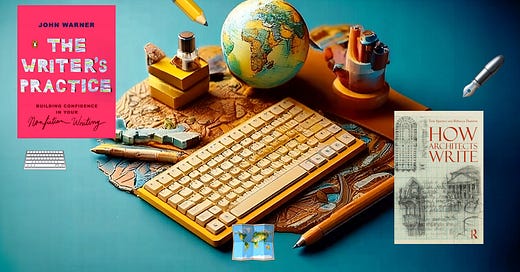Architectural education traditionally concentrates only on drawing, which is one skill. Until recently, all spatial imagination was addressed through this lens. As technology develops, mapping is made necessary. Computational design requires coding as an addition, and now, there is writing to tie everything together. How Architects Write is a good record of a disciplinary past, and Writer’s Practice guides processes for the future. Spatial culture is a language to unpack. Listening, reading, writing, and speaking about it are the needs of the times. Manifestoes, conversations, reflections or project descriptors are all forms that worked in the past, but these must be updated.
Much was packed into drawing as subskills, which is what How Architects Write represents. Not many wrote manifestos or other texts in college, especially before the internet. Writing then was part of drawing practices. With the disciplinary landscape shifting faster than we can track, an urgency exists to help articulate the various dialects into which spatial discourses evolve. According to Warner, non-fictional writing begins as a telling of a lived experience; as our experiences change, so must its form. Unlike in the past when only very polished work was put out, social media has made the rough an accepted format. How a public practice evolves is an experience to unpack.
How do you listen architecture, how do you read architecture, how do you write architecture, and therefore, how do you speak architecture are investigations to pursue. If the present is understood, what the past was may be apparent. The role of writing on feeds is to locate reactions to the now-in session. Architectural writing as practice on social media is not the same as what it was when the blogs were in vogue. My reading of both books is to try and get to a position, which I must confess is still in the works. The observation in this miniature investigation is that the body of knowledge known as writing in architecture does not offer much; the answers desired lie in language cultures.
BOOK 01
2408270733 an essential set of internet architectural writing skills are
The next phase of generative AI, in addition to its embedding on devices, is in-app co-pilots. We have come a long way from writing just on a processor. Even if Word looks the same, several bells and whistles are added, like a new paste feature, which matches the document format and tone. Relearning how to use …
BOOK 02
2408290733 react, observe, analyse, synthesise extending John Warner’s Writer’s Practice
Architects are lazy writers. They write for other architects knowing very well, but few read. We do thoroughly flip through all the books we buy since we are trained to read drawings and images predominately. There are two states thereof: reading to draw and reading to wri…






